Resuscitation of old acoustics, instead of buying a new Chinese
Not so long ago, I was puzzled by the choice of acoustics for my PC. I was puzzled because earlier I had a Radiotehnika S30 + subwoofer on 75 Wt RMS and I wanted something no less in power.
As a result of searches on the Internet, as well as strolling through all the shops of the city, I stopped at several models that suited me for the price and characteristics.
1. Microlab PRO 3 - 127 $
2. Edifier C3 - 132 $
3. Logitech Z-2300 - 170 $
4. Edifier DA5000 Pro - 200 $
5. Microlab H-500 - 243 $
I didn’t find Edifer in the city, although the acoustics are pretty good at their own expense. Microlab PRO 3 sounded good, but the amplifier was clearly weak, and reviews on the Internet were not very pleased with regard to reliability. The sound is nice, but something is missing. Logitech Z-2300 was noted for excessive bass, the study of medium is good, but at low power. The Microlab N-500 did not like the sound of the subwoofer.
And then I remembered the Soviet speakers, in particular the S90 and Amphiton. I did not like the S90 externally, so I went in search of Amphitons. At the local radio market managed to find 25AS-027in far not the best condition. Initially, the seller wanted 75 cu, but after a short conversation, they managed to pick up the rarity for 40 cu
I brought them home, took it apart ... and I realized ... I realized that I got ... they needed a lot of restoration: the woofers were already glued, one of them distorted the sound a little on average, the midrange baskets were dead, instead of their native tweeters - Chinese trash, no crossovers.
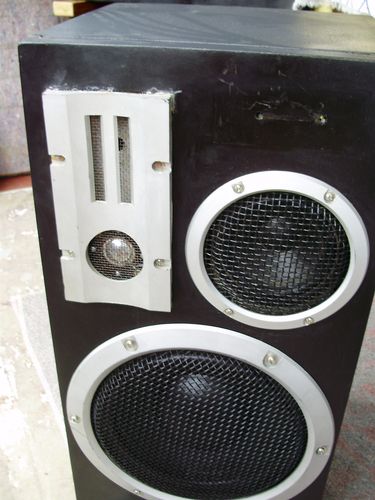

Therefore, I had to do a complete rework, which was not originally planned at all.
Because Apparently, the “boxes” were already about 20 years old, I decided to strengthen the corps. Moreover, the new low-frequency speakers had to stand compressor CW1002CX .
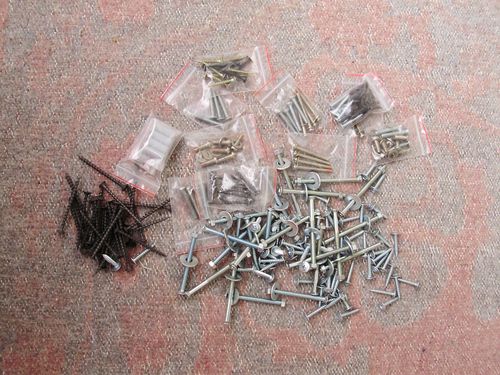
With the woofers actually had to tight. The first option was the DW100K with Kevlar suspension, but they could not be found, as well as the 4-ohm LW1000. But in the end, LW1000A8 settled in the drawers with an aluminum basket.
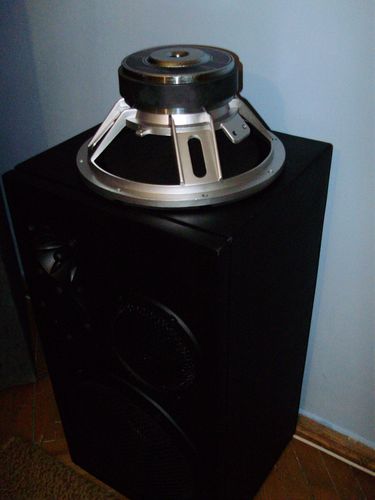
I was quite satisfied with the specifications: 130 Wt RMS in nominal mode, SPL 93 dB and a frequency range of 27 - 4000 Hz.
Midton left the original ones (to be exact, he originally took the new ones, but they did not fit the size and I returned them), honestly I won’t say the mark, because I didn’t find it, okay. True, I had to make new enlarged baskets for midrange. A dense cardboard was taken as a basis, on which flax-based material, previously impregnated with PVA glue, was applied layer by layer. The result was about 1.8 liters for the midrange head, which gave her more room for maneuvers, and the basket was additionally filled with fluffy cotton wool.
The inner surface of the boxes was completely treated with liquid glass glue in two layers, which made it possible to strengthen the structure of the tree and close the cracks that could cause whistling due to excessive pressure.
A powerful 40x60mm oak spacer is installed between the front and back of the ball. The fixing method is Titan glue, additionally 80 mm red-hot screws - 1 on the front panel and 2 on the back.
Also around the perimeter of the entire case were red-hot screws (about 40 per box), which provided greater rigidity. This step was necessary because initially, when assembling, the box was simply glued at the factory, and given the date of assembly, doubts arose about reliability.

Unfortunately, we could not find tweeters; we initially used 10GI-1 isodynamic heads. Therefore, the hefty hole had to be drowned. Their place was taken by the primitive piezo TE140 .
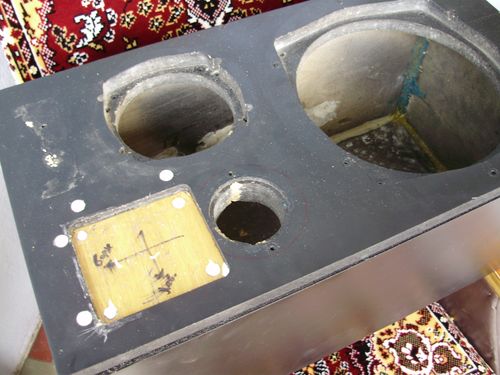
Silk Twitter was a good option, but the problem is that most have a frequency range of up to 16-18 kHz. An even better option was 4 bands, of which 2 twitter - silk + piezo, but firstly there are not enough places, and secondly filters on 4 channels are a rarity and expensive. Although, if you try hard, you could turn on the piezo sequentially through the capacitor, and silk tweet directly to the 3-channel. And then a new problem appears - impedance.
Therefore, I put a simple piezo. In practice, we get saturated high. Although - an amateur, because the piezo delivers treble more in C-tones, and silk tweets in C-tones, more bearable for the ear. Incidentally, the piezo speakers are also installed on the disco speakers.
The standard phase inverter did not suit me, especially since it was planned to produce damping, which ultimately significantly reduced the volume. Therefore, I installed professional telescopic pipes 65 mm in diameter. With the calculation of the length of the pipe, I did not bother, I left the base 120 mm, and as it became clear later, I guessed.
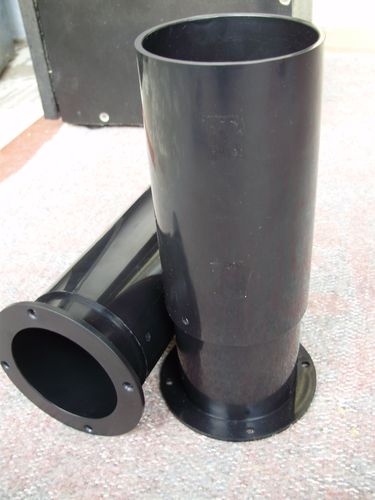
There were no standard separation filters left, so I had to look for a way out, which became the 3-way PYRAMID CR48 Gold Series crossovers. The
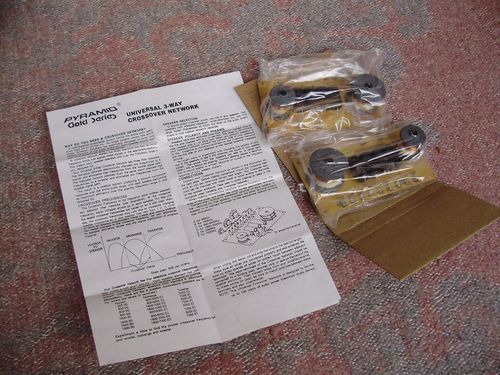
old cables were thrown into the landfill, and copper cables with a cross-section of 2x1.5 mm replaced them. Unfortunately, the banana jacks were not found, so simple clamps were installed on the back wall. In the future, "bananas" are still planned.
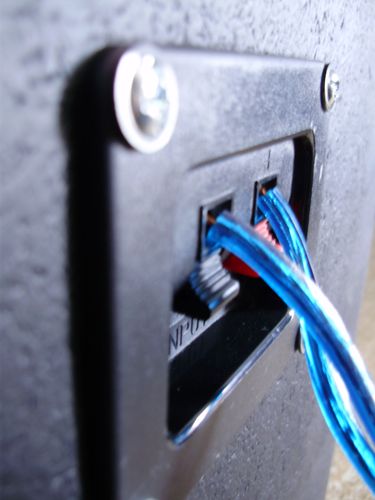
As a result, all this was put together, twisted, welded and sealed ... with plasticine.
The inner space was damped as follows: 2 layers of foam rubber with felt coating with a total thickness of about 40 mm were glued to the side, upper, lower and rear panels.
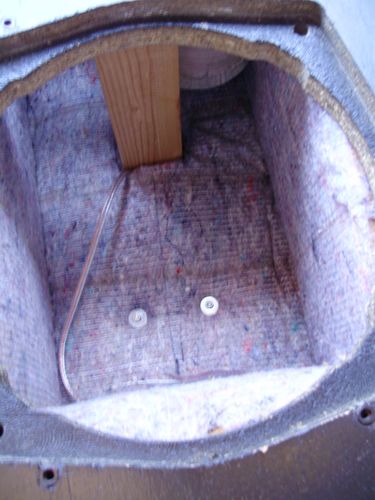
The boxes were plastered with car putty, sanded and painted with matte black paint with acrylic varnish.

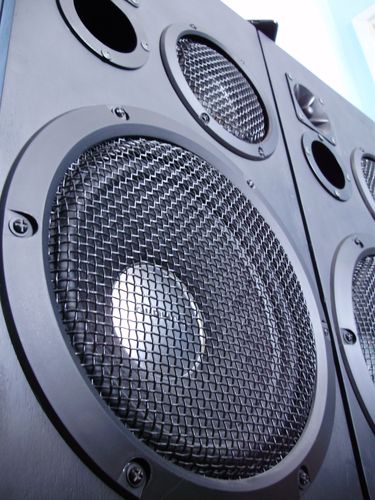
+ for the columns themselves $ 40
+ 2 low-frequency 95 $
+ twitter 5 cu
+ crossovers $ 30
+ pipes / phase inverters 18 cu
+ speaker cable 5 cu
+ bolts, screws 12 c.u.
+ glue, putty, 2 spray cans, sandpaper 15 c.u.
+ rubber legs 6 c.u.
+ plasticine 2 c.u.
- foam rubber and felt were available
- we do not consider the cost of the power tool
- flux, solder, acid also do not count
Total ~ $ 230
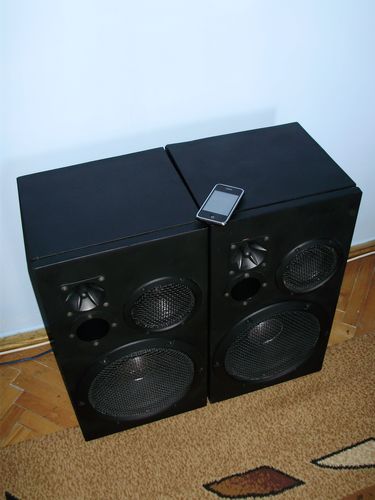
It should be noted that for this acoustics an external amplifier is required. Under the arms, of course, which was not. Therefore, I had to use the Gembird 2x22Wt RMS for the test.
The first connection, the first tracks ... and already at 20 Wt RMS (out of 130) it became clear that the money was not wasted. The output was a soft, rich and most importantly powerful bass that did not interfere with midtones, pronounced twitter, the vocals were very well designed and distinct.
Never before have Rock, Electro and Vocal sounded like that in my home environment. It remains only to buy a powerful amplifier.
Thanks for attention.
As a result of searches on the Internet, as well as strolling through all the shops of the city, I stopped at several models that suited me for the price and characteristics.
Applicants
1. Microlab PRO 3 - 127 $
2. Edifier C3 - 132 $
3. Logitech Z-2300 - 170 $
4. Edifier DA5000 Pro - 200 $
5. Microlab H-500 - 243 $
I didn’t find Edifer in the city, although the acoustics are pretty good at their own expense. Microlab PRO 3 sounded good, but the amplifier was clearly weak, and reviews on the Internet were not very pleased with regard to reliability. The sound is nice, but something is missing. Logitech Z-2300 was noted for excessive bass, the study of medium is good, but at low power. The Microlab N-500 did not like the sound of the subwoofer.
And then I remembered the Soviet speakers, in particular the S90 and Amphiton. I did not like the S90 externally, so I went in search of Amphitons. At the local radio market managed to find 25AS-027in far not the best condition. Initially, the seller wanted 75 cu, but after a short conversation, they managed to pick up the rarity for 40 cu
First cursory inspection
I brought them home, took it apart ... and I realized ... I realized that I got ... they needed a lot of restoration: the woofers were already glued, one of them distorted the sound a little on average, the midrange baskets were dead, instead of their native tweeters - Chinese trash, no crossovers.


Therefore, I had to do a complete rework, which was not originally planned at all.
So it all began ...
Because Apparently, the “boxes” were already about 20 years old, I decided to strengthen the corps. Moreover, the new low-frequency speakers had to stand compressor CW1002CX .

With the woofers actually had to tight. The first option was the DW100K with Kevlar suspension, but they could not be found, as well as the 4-ohm LW1000. But in the end, LW1000A8 settled in the drawers with an aluminum basket.

I was quite satisfied with the specifications: 130 Wt RMS in nominal mode, SPL 93 dB and a frequency range of 27 - 4000 Hz.
Midton left the original ones (to be exact, he originally took the new ones, but they did not fit the size and I returned them), honestly I won’t say the mark, because I didn’t find it, okay. True, I had to make new enlarged baskets for midrange. A dense cardboard was taken as a basis, on which flax-based material, previously impregnated with PVA glue, was applied layer by layer. The result was about 1.8 liters for the midrange head, which gave her more room for maneuvers, and the basket was additionally filled with fluffy cotton wool.
The inner surface of the boxes was completely treated with liquid glass glue in two layers, which made it possible to strengthen the structure of the tree and close the cracks that could cause whistling due to excessive pressure.
A powerful 40x60mm oak spacer is installed between the front and back of the ball. The fixing method is Titan glue, additionally 80 mm red-hot screws - 1 on the front panel and 2 on the back.
Also around the perimeter of the entire case were red-hot screws (about 40 per box), which provided greater rigidity. This step was necessary because initially, when assembling, the box was simply glued at the factory, and given the date of assembly, doubts arose about reliability.

Unfortunately, we could not find tweeters; we initially used 10GI-1 isodynamic heads. Therefore, the hefty hole had to be drowned. Their place was taken by the primitive piezo TE140 .

Silk Twitter was a good option, but the problem is that most have a frequency range of up to 16-18 kHz. An even better option was 4 bands, of which 2 twitter - silk + piezo, but firstly there are not enough places, and secondly filters on 4 channels are a rarity and expensive. Although, if you try hard, you could turn on the piezo sequentially through the capacitor, and silk tweet directly to the 3-channel. And then a new problem appears - impedance.
Therefore, I put a simple piezo. In practice, we get saturated high. Although - an amateur, because the piezo delivers treble more in C-tones, and silk tweets in C-tones, more bearable for the ear. Incidentally, the piezo speakers are also installed on the disco speakers.
The standard phase inverter did not suit me, especially since it was planned to produce damping, which ultimately significantly reduced the volume. Therefore, I installed professional telescopic pipes 65 mm in diameter. With the calculation of the length of the pipe, I did not bother, I left the base 120 mm, and as it became clear later, I guessed.

There were no standard separation filters left, so I had to look for a way out, which became the 3-way PYRAMID CR48 Gold Series crossovers. The

old cables were thrown into the landfill, and copper cables with a cross-section of 2x1.5 mm replaced them. Unfortunately, the banana jacks were not found, so simple clamps were installed on the back wall. In the future, "bananas" are still planned.

As a result, all this was put together, twisted, welded and sealed ... with plasticine.
Damping
The inner space was damped as follows: 2 layers of foam rubber with felt coating with a total thickness of about 40 mm were glued to the side, upper, lower and rear panels.

The boxes were plastered with car putty, sanded and painted with matte black paint with acrylic varnish.
As a result, the following


the total cost
+ for the columns themselves $ 40
+ 2 low-frequency 95 $
+ twitter 5 cu
+ crossovers $ 30
+ pipes / phase inverters 18 cu
+ speaker cable 5 cu
+ bolts, screws 12 c.u.
+ glue, putty, 2 spray cans, sandpaper 15 c.u.
+ rubber legs 6 c.u.
+ plasticine 2 c.u.
- foam rubber and felt were available
- we do not consider the cost of the power tool
- flux, solder, acid also do not count
Total ~ $ 230

It should be noted that for this acoustics an external amplifier is required. Under the arms, of course, which was not. Therefore, I had to use the Gembird 2x22Wt RMS for the test.
The first connection, the first tracks ... and already at 20 Wt RMS (out of 130) it became clear that the money was not wasted. The output was a soft, rich and most importantly powerful bass that did not interfere with midtones, pronounced twitter, the vocals were very well designed and distinct.
Never before have Rock, Electro and Vocal sounded like that in my home environment. It remains only to buy a powerful amplifier.
Thanks for attention.
